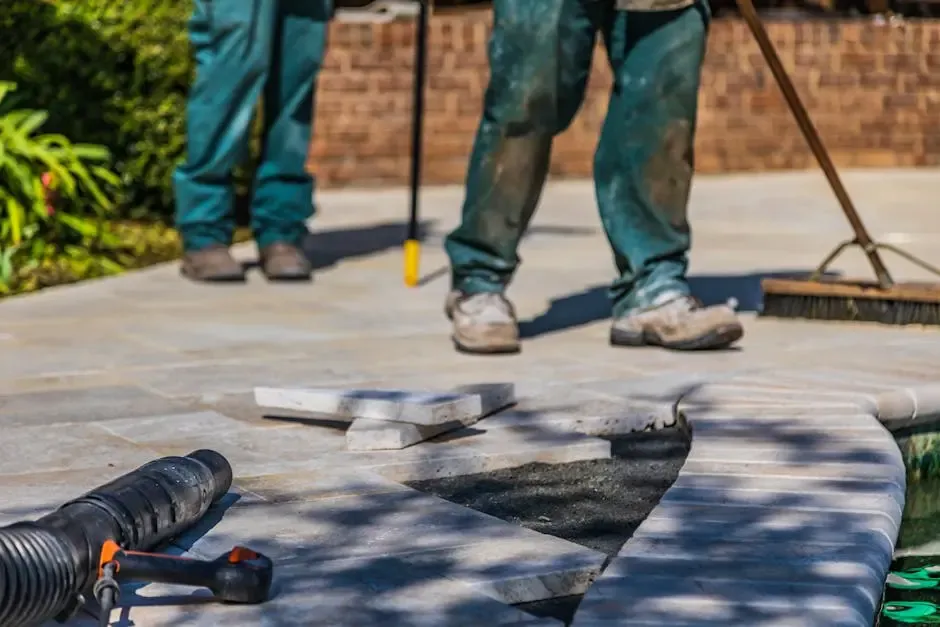
10 Steps to Building the Perfect Flagstone Patio
Creating a flagstone patio can transform your outdoor space into a beautiful oasis perfect for relaxation and entertaining. This guide will walk you through each step, ensuring that you’ll have a stunning patio to enjoy for years to come.
1. Choosing the Right Location
Finding the perfect spot for your flagstone patio is essential. Consider sun exposure, accessibility, and how it complements your landscaping.
You’ll want to observe how sunlight travels across your yard throughout the day. If you envision sipping morning coffee or hosting evening dinners, pick a location that allows for ample sunlight during those times.
Additionally, consider accessibility. Is your patio easy to reach from your home? Think about walkways and how they connect to the rest of your yard — making everything flow smoothly is key.
Lastly, analyze the overall aesthetic. Your patio should blend harmoniously with existing structures, trees, and plants. A well-chosen spot can enhance the beauty of your garden as a whole.
2. Selecting Quality Flagstone
The type of flagstone you choose plays a critical role in the overall look and durability of your patio. Explore your options and find the best fit for your style.
When selecting flagstone, consider colors and textures. Do you prefer the warm earthy tones of sandstone, or are the cool blues and grays of slate more your style? Each stone tells a different story and sets a distinct mood.
Beyond aesthetics, you should also assess the stone’s durability. Is it suitable for your climate? If you live in an area with heavy rainfall, select a density that can withstand moisture to prevent cracking.
Lastly, don’t overlook the shape of the stones. Irregular shapes can provide a more natural look, while rectangular pieces can create clean lines. Choose what aligns with your vision of an inviting outdoor space.
3. Gathering Essential Tools and Materials
Before you start laying stone, ensure you have all the necessary tools and materials. This includes a level, weed barrier, gravel, and of course, your flagstone.
You’ll also benefit from having a rubber mallet for snug placements and a stone saw for any necessary adjustments to fit your chosen design. A bucket can be handy for mixing mortars or carrying small tools.
Don’t forget safety equipment! Work gloves will protect your hands, and sturdy shoes can provide the support you need, especially while moving heavy stones. Overall, gathering these items ahead of time will make the process more efficient.
4. Preparing the Ground
A solid foundation is key for a long-lasting patio. Begin by excavating the area, removing grass or debris, and ensuring the ground is even.
When digging, aim for a depth of around 6 to 8 inches. This allows enough space for gravel and sand, which are essential for proper drainage and stability. Use a rake to level the area thoroughly.
Once you’ve cleared and leveled the ground, consider installing a weed barrier to prevent unwanted growth from disrupting the aesthetics over time. This extra precaution can save you maintenance woes in the future.
5. Creating a Solid Base
Add a layer of gravel to create a stable base. This will help with drainage and prevent settling over time.
Spread the gravel evenly and compact it down using a plate compactor. You want a solid foundation that can withstand pressure and ensure your stones will remain level for years.
Then, you might want to add a thin layer of sand over the gravel. This acts as a bedding layer for your flagstone and can help ensure that each piece is set evenly and compactly.
6. Laying Out the Flagstone Pattern
Plan your design by laying out the stones without cement first. This allows you to visualize your pattern and make adjustments as necessary.
Take your time here! Move the stones around until you find a pattern that you love. There’s beauty in arranging them meticulously or embracing a more organic flow.
Use smaller stones to fill in gaps — this can create visual interest and eliminate unsightly spaces. Just remember, balance and flow are what you’re aiming for!
7. Securing the Flagstone
Once you’re happy with the layout, it’s time to secure the stones. Use mortar or sand to fill in joints and keep stones in place.
Applying a consistent amount of grout between stones is crucial, as this not only holds the stones but also prevents weeds from growing through the cracks. Choose a color for the grout that enhances and complements the flagstone.
As you work, press each piece down to ensure it’s level and stable. Give the patio a gentle press here and there, ensuring they don’t wiggle underfoot.
8. Incorporating Drainage Solutions
Effective drainage is crucial. Consider adding trenches or sloped edges to direct water away from your patio.
Failing to address drainage during installation can lead to costly repairs later on. Take the time to evaluate how rainwater flows across your space.
A slight slope away from your home will help prevent water pooling. Additionally, creating a trench on one side can channel water into a drain or natural area in your yard.
9. Adding Finishing Touches
Enhance your patio’s beauty with flower beds, outdoor furniture, or decorative lighting. These final touches can make your outdoor space inviting.
Consider adding low-maintenance perennials along the edges to soften the hardscape. This not only frames your new patio beautifully but also attracts pollinators, truly elevating the outdoor experience.
Outdoor furniture creates an inviting space for relaxation or entertaining friends and family. Whether it’s a cozy chair, a sturdy table, or an elegant umbrella, choose items that fit your style and needs.
10. Maintaining Your Flagstone Patio
Regular maintenance will keep your patio looking great. Learn how to properly clean and care for your flagstone to ensure longevity.
Start by sweeping away leaves and debris regularly, as this prevents stains and mold from developing. You may want to occasionally wash the stones with a gentle cleanser to maintain their vibrant look.
If you notice any cracks or chips, address them immediately with mortar. By keeping a close eye on your patio, you can catch issues before they grow into larger problems.

